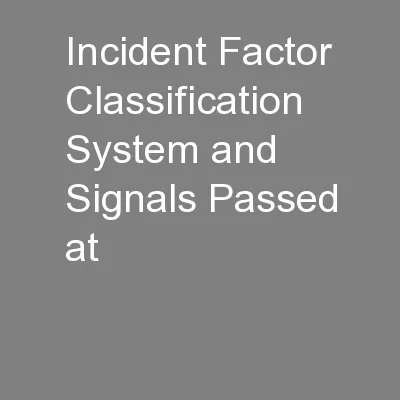/


Huw Gibson Ann Mills Dan Basacik Chris Harrison Overview Introduction to the Incident Factor Classification System database Signals Passed at Danger SPAD study using IFCS data SPAD probabilities and the Human Reliability Assessment ID: 351733
Download Presentation The PPT/PDF document "Incident Factor Classification System an..." is the property of its rightful owner. Permission is granted to download and print the materials on this web site for personal, non-commercial use only, and to display it on your personal computer provided you do not modify the materials and that you retain all copyright notices contained in the materials. By downloading content from our website, you accept the terms of this agreement.
Slide1
Incident Factor Classification System and Signals Passed at Danger
Huw Gibson, Ann Mills, Dan Basacik, Chris HarrisonSlide2
Overview
Introduction to the Incident Factor Classification System database
Signals Passed at Danger (SPAD) study using IFCS data
SPAD probabilities and the Human Reliability AssessmentFatigue study (see paper)
2Slide3
IFCS
Database
The Incident Factor Classification System (IFCS)
Event details: What, when, where
Event causes: How, why
Human
Error/ Violation
Classification
Ten incident factor classification
SPAD Investigation Reports
3
Safety management information system (SMIS)Slide4
4
Equipment
Environment
Knowledge, skills and experience
CommunicationSlide5
5
Information
Practices and Processes
Personal Factors
Supervision and Management
Workload
TeamworkSlide6
Ten Incident Factors – Alstom Prompt Card
6
The 10 incident factorsSlide7
SPAD Data Collected
257 SPAD Incident Investigation Reports Reviewed
924 Causal/Contributory Factors, average
four per incident197 Passenger, 54 Freight, 184 Network RailBy Year:7
2011
2012
2013
2014
70
62
116
9Slide8
SPAD 10
I
ncident Factor causes
8Slide9
The ‘TOP 5’ things to deal with
9
No
Passenger
Freight
Network Rail
1
Personal
12%
Knowledge, skills and experience
22%
Equipment
15%
2
Knowledge, skills and experience
9%
Equipment
17%
Communication
7%
3
Supervision/
Management
9%
Communication
13%
Practices
/ Processes
5%
4
Communication
8%
Personal
13%
Supervision/ Management
5%
5
Workload
5%
Supervision/ Management
13%
Work environment
2%Slide10
SPAD Workshops
9 cross-company workshops
Separate front line staff and manager workshops
60 participants:9 freight companies13 passenger companiesNetwork RailChallenges to existing management approaches for key areas:Route knowledge (knowledge, skills and experience), safety critical communications (communications), signal design and layouts (equipment), fatigue and health (personal)
Good alignment between ten factor data and driver views
Positive interest in seeing ten incident factor data for their company
10Slide11
What is going to change at railway companies?
Re-balance the approach to SPAD investigations to more reliably identify underlying causes, as they can currently have a bias towards considering driver performance rather than underlying factors.
Identify trends in underlying causes across SPAD incidents, in addition to managing each incident through recommendations and local actions, with the aim of focusing SPAD management on
key underlying causes.Include front line staff (particularly drivers), managers and directors in the review of underlying causes across SPAD incidents. The reviews to have the objective of identifying and prioritising improvements to company processes for managing SPADs. 11Slide12
SPAD Likelihood
Generally a driver error, slip/lapse at the front line
Often normalised by train miles
Best normaliser is number of times drivers are required to stop at red aspectsUniversity of Huddersfield and RSSB project ongoing to collect normaliser data from UK national data feeds7,500,000 red lights where drivers need to stop estimated per annum300 SPADs per year Annual human error probability: 0.00004; 1 in 25,000Lowest Railway Action Reliability Assessment value: 0.00002;
1 in
50,000
Lots of non-optimal signal designs out there
12Slide13
SPAD likelihoods – a little deeper
(Nikandros and Tombs, 2007
)
Australian dataSignal which is stopped at rarely, mostly green (red 1 in 1000 approaches) SPAD probability 0.001 – 1 in 1,000Signal which is stopped at often, mostly red (red 990 times in 1000 approaches) SPAD probability is 0.000006 – 1 in 166,667
166 times worse
13Slide14
HRA Society
http://
hrasociety.org/
“The Human Reliability Analysis (HRA) Society gathers HRA professionals (practitioners, developers, and researchers) with the goal to improve safety in our society through its contributions to risk assessment and, in particular, to enhance qualitative and quantitative human performance prediction in safety analyses.”“Glue between HF and Risk/Engineering”14Slide15
Conclusions
Incident Factor Classification System project ongoing: understanding human performance and underlying causes across incidents.
Data on SPADs, orienting to underlying causes.
Data on fatigue and its contribution to railway incidents.Leading to national changes in safety reporting (SMIS+).Guidance to support investigators in capturing and classifying 10 incident factors and errors/violations delivered in 2016. Future: data understood and acted on at a company rather than a national level. Cross-company coordination still required to manage specific issues.
15Slide16
Any questions?